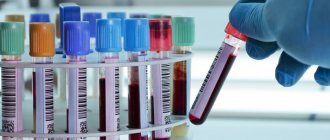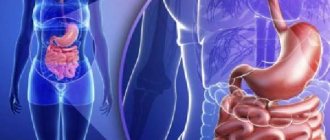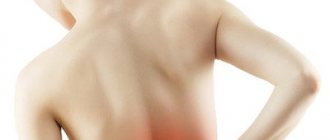Diagnosis and conservative treatment of sliding hiatal hernia
To confirm the diagnosis, the following additional research methods are performed:
- X-ray of the esophagus with contrast solution;
- Fiber dudenoscopy is an examination of the walls of the esophagus and the initial part of the stomach using fiber optics.
Using objective research methods, it is possible to determine the length of the esophagus, the expansion of its mouth above the fibrous ring.
The picture of the mucous membrane is also clearly visible, defects and ulcers are visible.
With a confirmed diagnosis of a sliding hiatal hernia, treatment is carried out conservatively.
Modern drugs are used that neutralize hydrochloric acid and reduce its production - proton pump inhibitors (omeprazole group), antacids that reduce the aggressive effect of hydrochloric acid (almagel group), prokinetics (ranitidine, domperidone).
If the size of the hernia is small and sphincter function is preserved, conservative treatment is successful, but requires regularity.
Each break in taking medications can provoke reflux esophagitis of even greater severity than before treatment.
Like other hiatal protrusions, a sliding hernia is diagnosed radiographically.
How the disease develops
The abdominal and thoracic cavities are separated by a diaphragm - a thin plate of muscle tissue that serves to separate these cavities and isolate the lungs, heart and aorta from the abdominal organs: stomach, liver, large, small intestine, etc. The diaphragm has a large opening for the esophagus. In normal conditions, the diameters of the esophagus and opening are equal.
For certain reasons, the esophageal opening expands, as a result of which part of the stomach, and in severe cases the entire stomach, penetrates into the chest cavity. An increase in the size of the esophageal opening of the diaphragm can be provoked even by the seemingly harmless habit of eating heavily, and then lying on the sofa for hours or, conversely, doing heavy physical labor on a full stomach. As a result, the following often begin to appear:
- heartburn;
- belching;
- pain localized in the chest area;
- interruptions in heart function.
Such phenomena occur as a result of the penetration of gastric contents into the esophagus due to the incorrect functioning of the cardiac sphincter - a muscle ring that closes the transition from the esophagus to the gastric chamber.
Is a gastric hernia dangerous?
Today, some experts believe that in the situation with a gastric hernia, the colors are somewhat thickened: many patients feel quite normal until the moment when, during an examination, a hernia is suddenly discovered. Having read all sorts of pseudo-scientific literature, such patients torment themselves and those around them with their slightly exaggerated suffering. This fact is evidence that, to a certain extent, gastric hernia is a psychosomatic type of disease.
General description of the pathology
To begin with, to recreate a complete understanding of the disease, we should consider the anatomical details. The diaphragm is a special muscular plate designed to separate the abdominal cavity and the thoracic cavity. If the muscles weaken in the diaphragm, then there is a high probability of penetration of the esophagus through the hole into the adjacent cavity. Weakened muscles, supported by intrauterine pressure, contribute to the protrusion of the stomach with a section of the esophagus into the chest cavity, thus developing a hiatal hernia.
Attention! It is necessary to consult a specialist in a timely manner to confirm the diagnosis in order to avoid surgical intervention.
Combination of hiatal hernia with other gastrointestinal diseases
Conservative methods
This hernia is most often treated conservatively. Since a violation of the anatomical relationship of the stomach and esophagus leads to the reflux of gastric contents into the esophageal lumen, this disease is always accompanied by inflammation of the esophageal walls.
The goal of drug treatment is to protect the esophagus from the action of aggressive stomach contents. To do this, the doctor uses coating drugs - antacids.
At the same time, the doctor carries out treatment aimed at reducing the acidity of gastric juice: drugs from the group of proton pump blockers (omeprazole, lansoprozole), H2-histamine receptor blockers (famotidine, ranitidine) are used:
- sleep with the head of the bed raised;
- avoid exercises and physical labor that increase intra-abdominal pressure;
- do not work at an angle;
- do not wear clothes that compress the chest and abdomen.
Treatment tactics
Hernia treatment - surgical
Treatment of gastric hernia is carried out using conservative methods. For large protrusions and deterioration in the passage of food, surgical treatment is indicated.
Medication tactics
The disease is always accompanied by an inflammatory process affecting the walls of the esophagus. The following groups of drugs will help improve the patient’s condition:
- Antacids – relieve the negative consequences of reflux.
- Proton pump inhibitors, histamine receptor blockers - to reduce the acidity of gastric juice.
Read: Severe burping: causes and methods of elimination
Non-drug therapy
Consists of recommendations for patient behavior and nutritional adjustments.
What to do:
- Sleep only on a high pillow.
- Avoid strenuous physical activity.
- Do not work in a bent position.
- Adhere to the principles of proper nutrition.
- Avoid foods that cause belching and heartburn.
- Eat small portions. Food should only be warm.
Important! If you have a gastric hernia, it is forbidden to overeat! Body weight must be constantly monitored. Physical activity is not prohibited. But you should discuss this issue with your doctor.
Surgical treatment
Surgery is the only reliable method for eliminating protrusion of the stomach wall. Fundoplication is indicated in the following cases:
- if drug therapy is ineffective;
- with the development of complications - an ulcer, including a perforated one, bleeding, inflammatory processes in tissues, suspicion of the tumor nature of the disease;
- strangulated hernia;
- stenosis, perforation of the esophagus;
- the disease is accompanied by severe digestive disorders.
Surgical interventions are performed either using direct access or laparoscopically. The classic method is Nissen fundoplication. In this case, the stomach is wrapped around the esophageal tube, thus strengthening the hole in the diaphragm.
Surgical treatment is prohibited in the following cases:
- pregnancy, if a hernia is detected in a woman of reproductive age;
- lactation period;
- patients who have undergone resection of the stomach or spleen;
- relapse of the disease after undergoing fundoplication;
- shortening of the esophageal tube, regardless of etiology;
- carcinomas of any system in the acute stage, during the period of active treatment;
- diabetes mellitus in the stage of decompensation;
- esophageal motility disorder;
- general serious condition of the patient;
- sepsis;
- infectious diseases in the acute stage, including tuberculosis.
Surgical interventions for hiatal hernia are planned. Therefore, a week before surgery, you should stop taking anticoagulants and NSAIDs.
The operation is performed under general anesthesia. The duration of the procedure is from 40 minutes to 1 hour. The length of hospital stay for a laparoscopic procedure is 7 days. If broadband intervention is performed, the patient will be discharged within 10–14 days.
Read: Pain in the epigastrium, what causes the malaise, how to treat it
On the first day after the procedure, eating is prohibited. Then you should start with warm liquid or pureed dishes. Fatty, heavy, spicy - are strictly prohibited. Solid foods are introduced gradually in consultation with the doctor.
Dangers
The main complications of a hiatal hernia are:
- Chronic heartburn and chronic inflammation of the lower esophagus (reflux esophagitis),
- Anemia due to chronic bleeding in the lower esophagus,
- Ulcers and narrowing of the lower esophagus that cause difficulty swallowing,
- During sleep, secretions from the stomach can enter the esophagus and lungs, causing chronic cough, shortness of breath (asthma), and even pneumonia.
Finally, a mixed hernia can cause serious problems such as difficulty breathing or severe chest pain, especially in older people.
You should see a doctor if:
- symptoms of hiatal hernia appear,
- symptoms of a known hiatal hernia worsen or do not improve with treatment,
- new symptoms appear.
Diagnostic measures
A comprehensive examination will help establish the diagnosis. At the appointment, the doctor analyzes the patient’s complaints, family and personal history.
Instrumental diagnostic methods:
- Fibrogastroduodenoscopy is indicated in the presence of at least 1 sign of a disease of the gastrointestinal tract.
- X-ray is mandatory. Allows you to assess the condition of internal organs. With its help, erosions and ulcers, stenosis of the esophagus and inflammatory processes in the gastrointestinal tract are identified.
- pH-metry is an assessment of the frequency of episodes of reflux of stomach contents into the esophagus and oral cavity.
- Biopsy of a section of the gastric wall to exclude the malignant nature of the protrusion.
- Fecal occult blood test.
Surgery
Surgical treatment of hernia is used in exceptional cases. Indications for intervention are required. The reason for the operation is considered to be:
- large size of gastric protrusion;
- neglected condition dangerous to health;
- presence of complications;
- bleeding in the esophagus;
- strangulated hernia;
- digestive disorders;
- suspicion of malignant neoplasm;
- narrowing of the esophagus;
- lack of positive dynamics of conservative therapy;
- dysplasia of the mucous membrane of the esophagus and stomach.
Without treatment, an advanced hernia leads to severe complications. The patient develops conditions that are dangerous to health. The following consequences cannot be ruled out:
- perforation of the esophagus, stomach;
- cancer tumor;
- the appearance of bleeding;
- anemia;
- narrowing of the esophagus with scar formation;
- reduction in the length of the stomach;
- the occurrence of tissue necrosis;
- the appearance of erosions, ulcers on the mucous membranes of the esophagus and stomach.
A popular method of surgical treatment is excision of the hernia using the Nissen method. The operation is performed laparoscopically, and if there are contraindications, using a classic open approach. During the intervention:
- the surgeon wraps the fundus of the stomach around the esophagus;
- forms a cuff to prevent the reflux of gastric contents into the esophagus;
- the correct position of the lower esophageal sphincter is restored;
- the development of gastroesophageal reflux is stopped;
- organs begin to function normally.
Prerequisites for the occurrence
How to cure a gastric hernia, and what is it? In order to understand how to cure, it is worth understanding why such a pathology occurs. There are many reasons that stimulate the development of paraesophageal hernia. However, the disease can also be congenital. In such cases, it is associated with a developmental defect (this is a type of movement and change in nature and society associated with the transition from one quality, state to another, from old to new) of the stomach in the prenatal period and requires inevitable surgical intervention in childhood.
If we talk about acquired hernias, the factor determining their development is involutional changes, which are associated with weakening of the gastric ligaments. The prerequisite for such changes is dystrophic processes in connective tissue structures, which leads to atrophy and loss of their previous parameters - elasticity, strength, elasticity.
Other stimulating causes include conditions in which intra-abdominal pressure increases frequently or once, but critically, and specifically:
- 2nd, 3rd, etc. pregnancy;
- constant constipation;
- frequent severe cough;
- ascites;
- obesity;
- lifting weights – both periodic and one-time;
- frequent vomiting;
- blunt trauma to the abdomen.
Also, prolapse of the gastric mucosa into the digestive tract can be caused by impaired motility of the gastrointestinal tract. In addition, a shortening of the alimentary tract can cause the development of hernias.
The essence of the disease
The diaphragm separates the chest cavity and stomach. The esophagus is located between two cavities, penetrating through an opening in the diaphragm. Normally, the fibers of the diaphragm hold the tissues of the esophagus, preventing the organs of the gastrointestinal tract from entering the chest cavity. A common gastric hernia causes the ligaments located in the area of the opening to begin to weaken. If pressure increases inside the abdominal cavity, the stomach and esophagus are partially pushed into the chest cavity.
Return to contents
Symptoms of a gastric hernia
A hiatal hernia in its initial stage of development may not produce any significant symptoms, and those that are present are often not taken seriously. To identify these deviations, let's look at the symptoms of a gastric hernia using the table as an example:
Variety: Symptoms:
| Axial hernia 1st degree: |
|
| Axial hernia 2nd degree: |
|
| Paraesophageal: |
|
| Combined: | Combines different symptoms. |
An esophageal hernia manifests itself with the same symptoms and is most often diagnosed when other pathologies are identified. An esophageal hernia can cause inflammation of the mucous membrane or bleeding, so a hernia is dangerous for the esophagus only in advanced conditions. However, this does not mean that treatment of the pathology can be postponed until later.
Treatment
In most cases, treatment of a hernia in the stomach is carried out using conservative methods or folk remedies. They are united in that both folk remedies and conservative methods of treatment are carried out using diet. Proper nutrition in this situation is very important, as it allows not only to eliminate pain after eating, but also to speed up the healing process.
The main thing is that the patient’s diet and nutrition contain only approved foods. Such folk remedies can completely neutralize the manifestations of the clinical picture of the disease.
The diet for a hernia in the stomach has four basic nutritional rules:
- You can only eat warm food;
- meals should be taken in small portions. You need to eat at least 4-6 times during one day;
- meals should be fractional. Food should be chewed well and eaten slowly;
- The last meal should be three hours before bedtime.
- This diet includes the following foods that are approved by doctors:
- cereals, as well as low-fat dairy products;
- baked vegetables;
- boiled or baked fish, as well as cutlets;
- crackers;
- hard-boiled eggs.
How dangerous is the disease?
This is a serious disease that can cause severe complications that are dangerous to the health and life of the patient. It needs to be diagnosed and treated as soon as possible.
The disease is dangerous due to the following symptoms:
In this case, compression of part of the organ occurs in the area of the hernial orifice. With such prolonged exposure, blood flow is disrupted. The tissues do not receive the necessary substances, quickly die and die, and necrosis occurs. Gastric gangrene may develop.
This condition is manifested by severe acute pain, pallor of the patient, cold sweat, high pulse and blood pressure. Requires urgent surgical intervention.
- Perforation of the organ wall.
Perforation means the formation of a hole in the wall. Gastric contents are poured into the internal environment of the body, and diffuse peritonitis and sepsis can form. It also requires urgent surgical intervention.
An insidious complication that may not initially manifest itself. But large blood loss is very dangerous for human life. It manifests itself as pallor, anemia, vomiting mixed with blood, tarry black feces, and is treated promptly.
- Disruption of digestion processes and the entry of important elements into the body.
- Transition of a hernia into a malignant neoplasm.
If the disease persists for a long time, mutation processes can occur. Cell atypia and dysplasia of the damaged area will occur, all of which can cause cancer.










